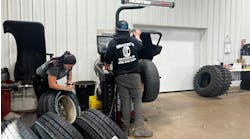Our recent industry checks with tire dealers indicate that retail sellout trends remain flat. Sellout in November 2023, the latest month for which data is available, was approximately flat on a year-over-year basis, following negative trends seen in October, when a 1.9% decline was reported.
While sellout trends are far from robust, we note just two months last year saw positive sellout trends - thus the November 2023 result is a slight improvement compared to the majority of the year.
Looking closer at volume for the month of November on a regional basis, the Southeast region saw the strongest trends, growing 5.2% year-over-year. On the negative side, the Northeast region saw the softest trends, down 3.1% on a year-over-year basis, marking the second straight month that the Northeast reported the weakest results in our survey.
We note in late-October, commentary from industry powerhouse Monro Inc., which is deeply penetrated in the Northeast market, indicated that its October same store sales trends on a month-to-date basis were down 5.4% year-over-year and it appears this trend continued into November, based on our recent survey.
Based on feedback from the tire dealer community, it appears that the inflationary environment and macroeconomic uncertainty are still impacting retail sellout levels.
We note that 10% of our independent dealer contacts saw positive demand trends in November, which was a solid sequential improvement from the net 40% of dealers who saw negative demand in October.
While commentary over the past few months has pointed toward continued consumer trade-down, our November survey, in particular, showed consistent feedback that the flat sellout levels seen during the month were driven by consumers opting for lower-priced tires, rather than more expensive tires.
While demand trends are always a bit finicky due to weather, calendar shifts, etc., dealers increasingly mentioned big box stores in our November survey as a curtailment to both tire demand and follow-up service offerings. That said, we continue to believe there is a hidden level of pent-up demand in the tire replacement market due to snowfall a year ago largely being consolidated into a few big storms, shortening the window for weather-related tire purchases.
Given this, along with recent feedback indicative of improving demand for lower-tier tires, we see a scenario in which demand remains positive as vehicle owners pursue needed maintenance with winter weather on the way.
We also note the year-over-year comparisons will become increasingly easier given the “green winter” seen a year ago.
Trade-down continues
Our recent survey of dealers indicates that tier-three brands were the most in-demand during the month of November. Said simply, the theme of consumer trade-down appeared to accelerate during November as several dealers indicated the combination of elevated tier-one tire prices and the difficult macro environment are pushing consumers toward lower-priced alternatives.
More specifically, one dealer estimated that 10% of buyers at his location are shopping based on quality, while 90% are shopping based on price. As such, tier-one tires remain in last place in our tire tier rankings for the third consecutive month.
Rounding out our tire tier rankings is tier-two tires, placing second during November following two straight months of being the most in-demand tier in our rankings. Frankly, our tire tier rankings during November are far from surprising given feedback from independent dealer contacts. Given still elevated prices for premium brands and the inflationary environment stretching consumers’ wallets, we find it logical that consumers are trading down to tier-two and tier-three brands.
Looking forward, we note consumers seem to change their preference for certain tires given the current economic situation. We continue to believe that longer-term, consumers will opt to tier-two tires as the strike the balance between cost and performance, particularly in the current inflationary environment.
A raw deal?
Turning to raw material costs, the basket of raw materials to make a basic replacement tire fell an average of 3.9% during November, following a 4.3% year-over-year decline during October. On a quarter-to-date basis, tire raw material costs were down an average of 4.1% year-over-year during the last quarter of 2023.
Holding raw material costs constant moving forward, we estimate this equated to a 2.9% year-over-year decline in input costs to “build a tire” during the fourth quarter.
Our raw material index has experienced year-over-year declines each month during 2023, though with the lapping of price declines on the horizon, we expect the rate of decline to continue to diminish moving forward.
With a level of stability in raw material prices and waning demand for top-tire tiers, we wonder if a level of incremental price concession could be on the horizon from premium tire manufacturers. However, our surveys continue to point towards a level of stickiness regarding upper-tier tire prices.
Further, recent commentary from Goodyear Tire & Rubber Co. indicates that the company expects price/mix versus raw materials to be a net benefit.
Based up on these items, we would not expect to see any price concession before the end of the year. That said, we do see the potential for price decreases at some point in 2024 as raw material costs continue to cool, inventory levels appear to be more normalized at this time and manufacturers may concede some price to encourage wholesalers and dealers to begin taking on more inventory.




